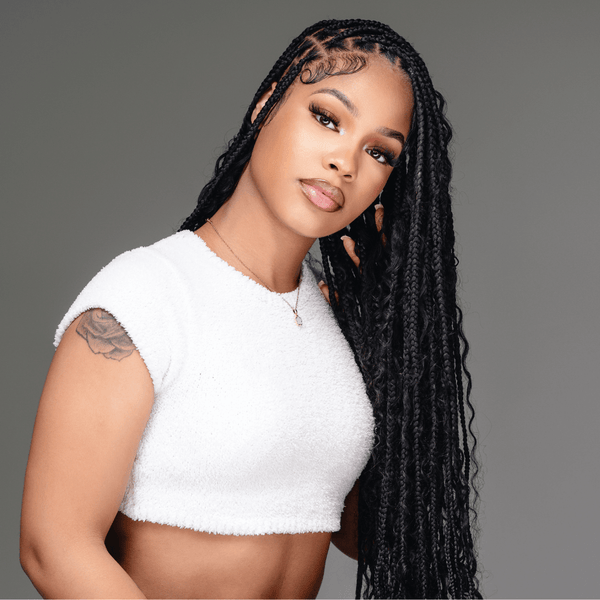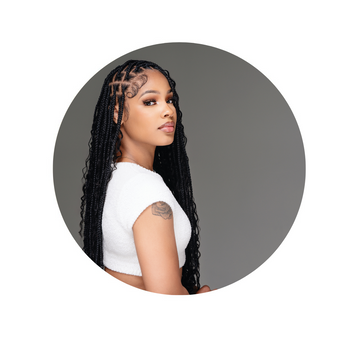Types of Human Hair for Braiding Explained
Choosing the right type of human hair for braiding is key to achieving the style, texture, and longevity you want. From Remy to virgin hair, each type offers unique characteristics that make it suitable for different braiding styles and maintenance needs. Here’s a breakdown of the main types of human hair used for braiding, along with their pros and cons to help you make an informed choice.
1. Remy Hair: The Premium Choice for Natural Texture
Remy hair is one of the highest quality options for braiding. It’s known for its cuticle alignment, where all hair strands are aligned in the same direction, making it less prone to tangling and matting. This alignment helps Remy hair retain its smooth texture and natural shine, providing a realistic look.
-
Pros:
- Natural Look and Feel: Remy hair offers a soft, realistic texture that blends well with most hair types.
- Durability: Cuticle alignment reduces tangling and matting, making the hair last longer and require less maintenance.
- Styling Flexibility: Can be dyed, curled, and straightened without significant damage.
-
Cons:
- Cost: Remy hair is typically more expensive than other types of human hair.
- Care Needs: While durable, it still requires proper care to maintain its smooth texture.
Best for: Individuals who prioritize quality and longevity, and are willing to invest in a higher-grade product. Remy hair is ideal for styles like box braids and knotless braids, where a natural look is essential.
2. Virgin Hair: Untreated for Maximum Styling Flexibility
Virgin hair refers to hair that has never been chemically processed, dyed, or treated. This makes it one of the most versatile types of human hair for braiding, as it retains its natural structure, color, and health. Virgin hair can be styled and colored to match your desired look.
-
Pros:
- Full Styling Freedom: Virgin hair can be dyed, permed, or styled without risk of reacting to prior chemical treatments.
- Long-Lasting Quality: Due to the lack of chemical processing, virgin hair is durable and maintains a natural luster.
- Natural Appearance: Virgin hair’s unaltered texture and color give it a soft, natural look.
-
Cons:
- Higher Price Point: Virgin hair is often more costly due to its untreated quality.
- Limited Color Choices: Because it is unprocessed, virgin hair is typically available in natural colors only, requiring dye if a different shade is desired.
Best for: Those who want full customization options and a high level of quality. Virgin hair is great for Senegalese twists, micro braids, and any other braids where styling flexibility is a priority.
3. Synthetic-Free Human Hair: An Affordable, Authentic Option
Synthetic-free human hair is another category, where 100% human hair is used but may have undergone some processing or mixing with similar hair types for affordability. While not as high-quality as virgin or Remy hair, synthetic-free human hair still provides a natural look and feel without the artificial shine of synthetic alternatives.
-
Pros:
- Natural Appearance: Despite minor processing, synthetic-free human hair maintains a realistic texture that mimics natural hair.
- Cost-Effective: More affordable than Remy or virgin hair, making it accessible for a variety of styles and budgets.
- Variety of Options: Available in a range of colors, lengths, and textures to suit different preferences.
-
Cons:
- Lower Durability: This type of hair may tangle or mat more easily than Remy or virgin hair.
- Limited Styling Options: May not hold up as well under high-heat styling or chemical processing.
Best for: Budget-conscious individuals seeking a natural look for shorter-term styles. It’s suitable for braiding styles where cost is a factor, like feed-in braids or crochet braids, which require frequent refreshes.
4. Brazilian Hair: Thick, Voluminous Texture
Brazilian hair is known for its thick, voluminous texture, making it an excellent option for styles that need extra fullness and body. Brazilian hair can come in natural curly, wavy, or straight textures, offering versatility and durability for braiding styles.
-
Pros:
- Full, Thick Texture: Ideal for voluminous braids and larger styles like box braids or jumbo twists.
- Resilience: Brazilian hair is naturally strong, which allows it to maintain its shape and texture over time.
- Blends Well: Blends well with various hair textures, particularly those with naturally thicker hair.
-
Cons:
- Heavier Weight: The thickness of Brazilian hair can make it feel heavy, which may not be comfortable for everyone.
- Higher Price for Longer Lengths: Long lengths of Brazilian hair are more expensive due to the extra volume.
Best for: Individuals looking for thicker, voluminous braids with minimal styling. Brazilian hair is perfect for box braids, jumbo braids, and other styles where fullness is key.
5. Other Popular Types: Peruvian and Indian Hair
In addition to Remy, virgin, synthetic-free, and Brazilian hair, other types like Peruvian and Indian hair are also popular for braiding due to their unique textures.
-
Peruvian Hair: Known for its coarser texture and lightweight feel, Peruvian hair is ideal for thick, voluminous styles without the added weight. It’s a great choice for individuals with naturally thick hair.
-
Indian Hair: Known for its silky, smooth texture, Indian hair is excellent for creating sleek braids. It’s easy to style and holds up well in intricate braid styles.
Loxx Hair Tip: Peruvian hair is great for a natural, thick look, while Indian hair is best for those wanting sleek, smooth styles with a lightweight feel.
Final Thoughts
Choosing the right type of human hair for braiding depends on your style preferences, budget, and maintenance capabilities. Remy and virgin hair offer the highest quality and longevity, while Brazilian and synthetic-free options provide excellent volume and affordability. For unique textures, Peruvian and Indian hair are excellent alternatives to consider.














